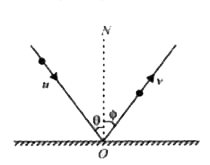In the previous question the angle ϕ is equal to
A
θ
B
tan−1[ηnθ]
C
tan−1[1etanθ]
D
(1+e)θ
Text Solution
The correct Answer is:C
|
Topper's Solved these Questions
- KINEMATICS, FORCESBOOK - D MUKHERJEECHAPTER - KINEMATICS, FORCESEXERCISE - Type 2
22 Videos
- KINEMATICS, FORCESBOOK - D MUKHERJEECHAPTER - KINEMATICS, FORCESEXERCISE - Revision Exercise
26 Videos
- IIT QUESTIONS 5BOOK - D MUKHERJEECHAPTER - IIT QUESTIONS 5EXERCISE - Matrix matching type
2 Videos
- MISCELLANEOUS QUESTION 1BOOK - D MUKHERJEECHAPTER - MISCELLANEOUS QUESTION 1EXERCISE - Miscellaneous Questions-1 (Straight-Objective Type)
54 Videos
Similar Questions
Knowledge Check
In the previous question, the rate of return is
Aequal to the rate of dividend.Bgreater than the rate of dividend.Cless than the rate of dividend.DEither (a) or (b)A particle strikes a horizontal frictionless floor with a speed u, at an angle θ with the vertical, and rebounds with a speed υ, at an angle ϕ with the vertical. The coefficient of restitution between the particle and the floor is e. The angle ϕ is equal to :
 AθBtan−1[etanθ]Ctan−![1etanθ]D(1+e)θ
AθBtan−1[etanθ]Ctan−![1etanθ]D(1+e)θA particle strikes a horizontal frictionless floor with a speed u at an angle θ with the vertical, and rebounds with a speed v at an angle ϕ with vertical. The coefficient of restitution between the particle and floor is e. The angle ϕ is equal to
 AθB(1+e)θCtan−1(etanθ)Dtan−1(1etanθ)
AθB(1+e)θCtan−1(etanθ)Dtan−1(1etanθ)
In previous problem, the angle of dip is
View SolutionIn previous question, the horizontal displacement (from the foot of the tower) of the ball is approximately equal to
View SolutionIn previous question, if both conductors carry equal currents in the same direction
View SolutionIn the previous problem, if (ϕ) is the angle between line of emergence DE and normal DF at point D, ratio of (ϕ)/(θ) for positive value of (θ) will be
View SolutionLet A={ϕ,{ϕ,{ϕ}},{ϕ,{ϕ},{ϕ,{ϕ}}}}, then total number of relations on A that are not function is equal to
View Solution
